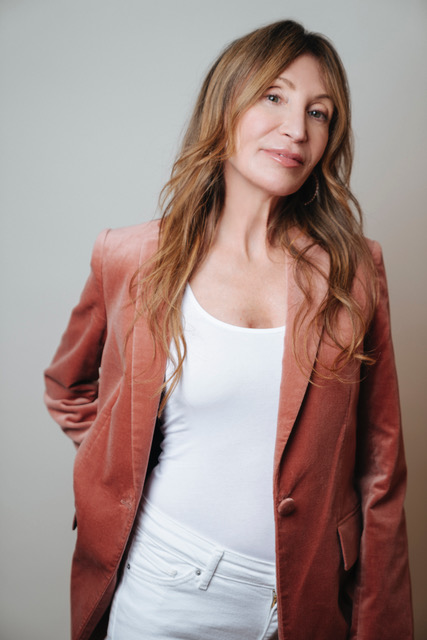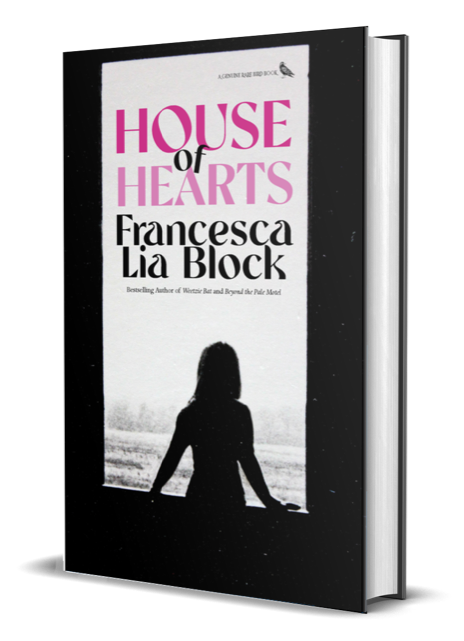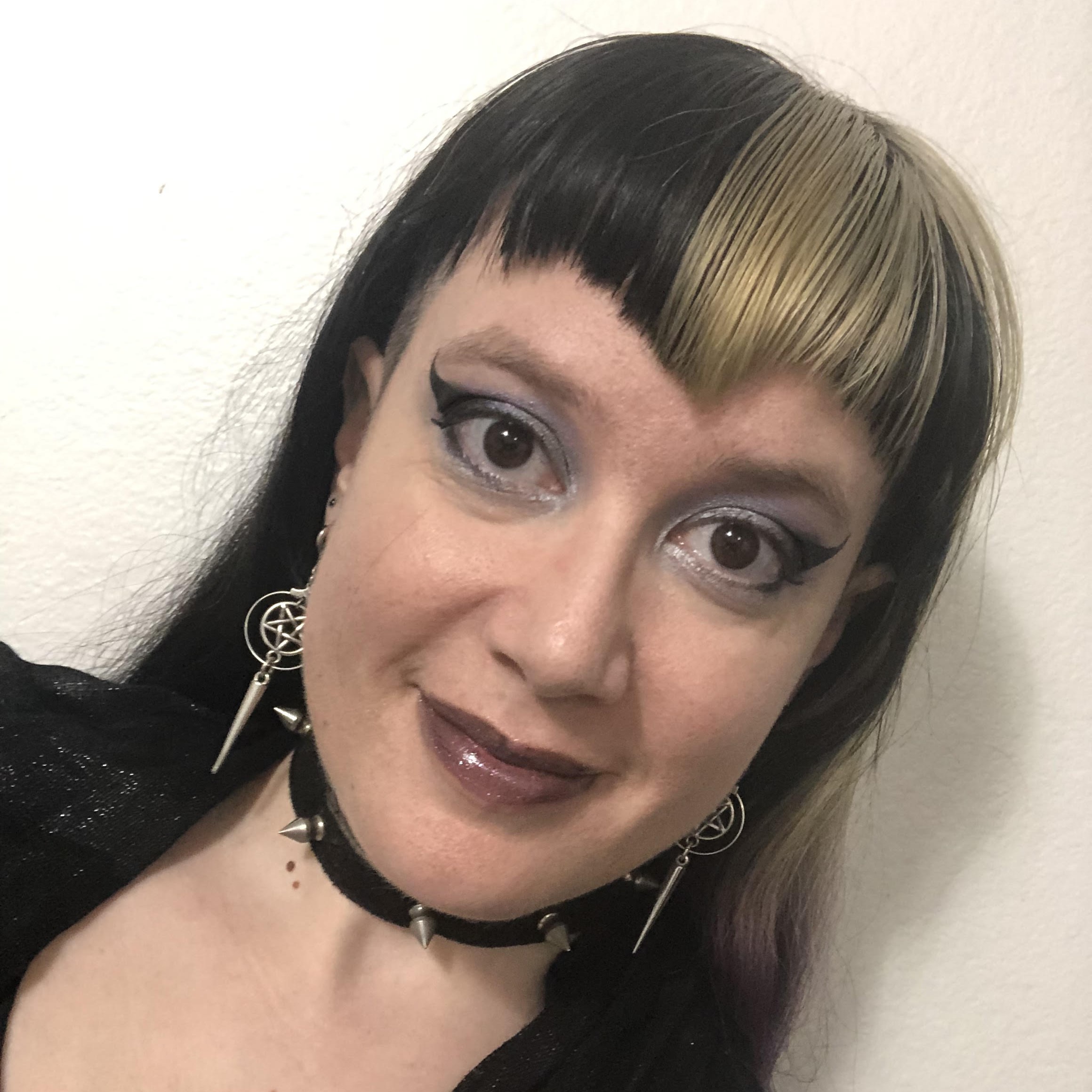Interview: TCR Talks with Francesca Lia Block
 photo credit: Madeline Northway
photo credit: Madeline Northway
By Natalie Ferrigno
Francesca Lia Block is the award-winning author of the beloved young adult series Dangerous Angels, which is set to be adapted for television. Block has written a vast bibliography of fiction, nonfiction, and poetry for all ages, across a wide spectrum of genres ranging from thriller to magical realism. Her newest novel, House of Hearts, is set for release on July 12. She is also a graduate of UCR Palm Desert’s MFA program. You can book one of her online courses at francescaliablock.com.
We caught up with Francesca to ask about the Egyptian myths that inspired her new book, her role on the show, and her fantasy cast for future adaptations.
THE COACHELLA REVIEW: Tell us about your new novel, House of Hearts. How would you describe it to a potential reader?
FRANCESCA LIA BLOCK: Izzy Ames lives with her high school sweetheart, Cyrus Rivera, in the Salton Sea area of the desert. They cling to each other and to their close friends, Nephy and Seth, to cope with the trauma of their pasts—until the morning Izzy awakes to find Cyrus has vanished.
When she realizes no one will help, Izzy takes matters into her own hands and decides to search for Cyrus alone. After weeks of looking for him, she discovers a clue that leads her to the House of Hearts retreat center, run by the mysterious Sky. At House of Hearts, Izzy meets an intriguing musician named Ever Fontana and, for a moment, she is able to forget the pain of her past. But when new clues about Cyrus’s disappearance surface, Izzy must go down into the dark to find the truth.
Izzy’s quest will take her into a world of sexuality, madness, and violence, where she will discover life-changing secrets not only about Cyrus but, ultimately, about herself.
TCR: There are so many themes and motifs present in your new book. Egyptian mythology, the brutality and beauty of the desert, cults, loss, and violence fill the pages. What initially inspired House of Hearts?
FLB: One night, I had a vision of a tall, young woman with dark hair and a scar on her face walking through the desert, on her way to rescue Catt, a character who had died in my novel Beyond the Pale Motel. This woman became Izzy Ames in House of Hearts. Although she never rescued Catt, she began to tell me her own story.
Nature, the danger of climate change, and true crime were other inspirations, as was Egyptian mythology, which I’ve always loved. My therapist, who passed away a few years ago, described the whole book as a fertility myth, and I hadn’t even realized that’s what I was writing.
The desert setting came from my own experience of living in Joshua Tree and visiting Desert Hot Springs, Salton City, Bombay Beach, and, of course, Palm Desert, for our [school] residencies. I seem always drawn to the desert. Once, while visiting Bombay Beach for research, we got lost and ended up in the middle of nowhere, facing two street signs that read “Isis” and “1st.” I took this as a sign.

TCR: Could you elaborate on what makes the book a fertility myth? Do you see it as its own unique myth or a modern retelling?
FLB: I don’t want to give it away, but House of Hearts is a retelling with lots of twists. In ancient times, fertility myths, cults, and rites were often about nature and the state of the earth as well as procreation, and in the book, I am referencing both.
TCR: In the acknowledgements, you listed a few books on Egyptian mythology that inspired you. When did you first become interested in the subject? Is there something special about it that resonates with you?
FLB: I was introduced to myths at a very young age and continued to explore them as inspiration for my work. The myth of Isis and Osiris has always haunted me, and I’ve wanted to write a book with elements of that myth for a long time. I think we are subconsciously drawn to the ancient stories that teach us what we need to know. For me, the story is about seeking the lover and ultimately finding the self.
TCR: What is it about the myth of Osiris and Isis that haunts you?
FLB: The quest for healing for the self, the beloved, and the planet.
TCR: Did you do any research on cults to create the House of Hearts and the character of Sky?
FLB: Yes, I relied especially on Isis and Osiris, by Jonathan Cott. But I made things darker.
TCR: What is Isis and Osiris, by Jonathan Cott, about? What elements from this book made it into House of Hearts?
FLB: It’s about various versions of the Isis/Osiris cult around the world, and I based some of the rituals on what I read.
TCR: You said you imagined Izzy attempting to rescue a character from another one of your novels. Do you see your characters as existing in the same fictional world? Could you imagine any of them meeting each other, either in your mind or on the page?
FLB: There isn’t usually crossover in my mind, unless characters are in a series like the Dangerous Angels books. However, all of my characters are a part of me. I relate this to the Jungian theory of dreams that states that everyone in the dream is a part of the dreamer. So in that sense, they are all connected in my mind (literally).
TCR: How did Izzy change and grow from when you first imagined her?
FLB: At first, I saw her as more of an actual detective and even interviewed a female PI as I developed Izzy’s character. She evolved into someone who is in search of answers to her own personal mystery. Although, who knows? She’s still young!
TCR: How did your experience getting your MFA from UCR change your writing? Were there any specific lessons or pieces of advice that factored into writing your latest work?
FLB: Deep critical dives into some of my favorite books, as well as into new books recommended by my mentors, taught me so much! So did working on a poetry intensive with Jill [Alexander Essbaum], because I started thinking a lot more about rhythm. Joshua [Malkin] taught me the screenwriting beats, and I ended up applying them to the novel after I’d written an early draft and a screenplay version. Stephen [Graham Jones] was amazing with supporting the “dreaming” part of the process and suggested books like The Magus, by John Fowles, and The Crying of Lot 49, by Thomas Pynchon. Tod [Goldberg] recommended Winter’s Bone, by Daniel Woodrell, and helped with some of the very practical issues of writing a thriller—creating more red herrings, eliminating things that might upset people on Goodreads. Oh, and my wonderful friends from the program gave me great notes, and I’m still exchanging work with some of them today. Those friendships alone were worth the cost of the program.
TCR: How does it feel to know Weetzie, the main character of Dangerous Angels, will finally be on the screen?
FLB: I’ve been waiting for this for over thirty years, so it is very exciting. [Executive producer] Sera Gamble still has to write the pilot and have it approved by the network, but they are eager to work with her.
TCR: Are there plans to include the Pink Smog and Necklace of Kisses stories in the Dangerous Angels series?
FLB: Thanks for asking! If it’s made, the studio will own the rights to all the books. It’s likely that the first season will be an expanded version of the first book, but I’m guessing Sera may include things from Pink Smog and maybe Baby Be-Bop since they are prequels.
TCR: Will you be involved in the making of the series? Any chance of a cameo?
FLB: I’ll be a producer and will write one script per season as well as consulting. No cameos, please!
TCR: What are you hoping to see in the Dangerous Angels adaptation? Do you have any ideas or wishes for the series?
FLB: It will be up to the show runner, but in my opinion, it should be a 1980s-punk L.A. fairy tale for grown-ups. A mix of Decline of Western Civilization, by Penelope Spheeris, and Juliet of the Spirits, by [Federico] Fellini. Dark and edgy but also magical and beautiful. Kind of Euphoria—set in the 80s—but with lots more magic and a strong female perspective.
TCR: If you could see another one of your works on-screen, which one would it be?
FLB: House of Hearts!
TCR: If House of Hearts were to be adapted, would you like to see it as a movie or a TV show? What would you envision for such an adaptation? Who would you like to see cast?
FLB: It would be amazing to have it done as a series. I could see Zendaya, Victoria Pedretti, Margaret Qualley, Scout LaRue Willis (who does the audio version) as Izzy. So many amazing young female actresses out there. Ideally, I’d love to again collaborate with my Game of Thrones producers, who are attached to Dangerous Angels.
TCR: Over your career, you’ve created works for all age groups and written across genres. What would represent something new for you? Is there a genre or style you’ve always wanted to try but haven’t given a shot yet?
FLB: I just want to write dark adult fairy tales and mythic retellings like House of Hearts for the rest of my life.
TCR: What are you focused on next?
FLB: It’s called Luv [sic]. It’s about a woman who is obsessed with grammar, fashion, and internet dating during the pandemic, while her friend, Lillibelle, torments her. It’s pretty dark, too, but it’s got a lot more humor, or at least, that’s what I’m going for!
 Natalie Ferrigno is a horror and dark fiction writer living in Colorado. She has a B.A. in writing from Ithaca College and an M.F.A. in creative writing from University of California, Riverside. Her short stories have been published in DM du Jour, New Skin Magazine, and Sanitarium Magazine. She has also written reviews and interviews for Dwarf + Giant. She has appeared on the podcasts Cemetery Confessions and Ladies of the Fright to discuss the vampire myth, her area of expertise.
Natalie Ferrigno is a horror and dark fiction writer living in Colorado. She has a B.A. in writing from Ithaca College and an M.F.A. in creative writing from University of California, Riverside. Her short stories have been published in DM du Jour, New Skin Magazine, and Sanitarium Magazine. She has also written reviews and interviews for Dwarf + Giant. She has appeared on the podcasts Cemetery Confessions and Ladies of the Fright to discuss the vampire myth, her area of expertise.
